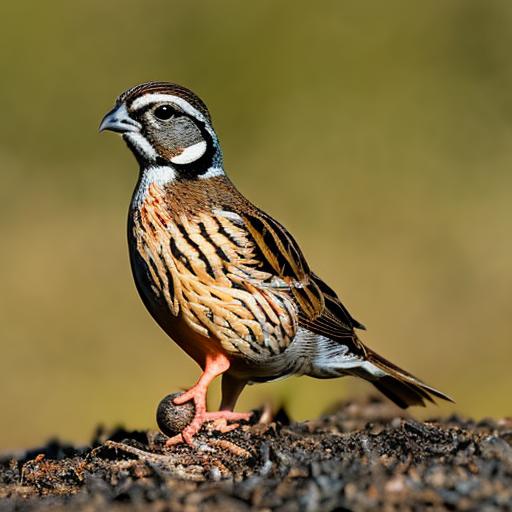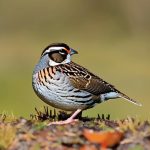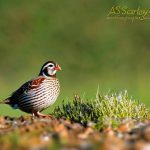Quail are small, ground-dwelling birds that are commonly used in dog training exercises, particularly for hunting and field work. They are an excellent choice for training dogs due to their size, agility, and natural scent. Quail are also relatively easy to care for and can be housed in a variety of environments, making them a convenient option for trainers. When used in training exercises, quail can help dogs develop their hunting instincts, improve their tracking abilities, and enhance their overall obedience and responsiveness to commands. Additionally, quail can be used to simulate real-life hunting scenarios, providing dogs with valuable experience and preparation for actual hunting expeditions. Overall, quail are a versatile and effective tool for dog training, and their use can greatly benefit both trainers and their canine companions.
Quail are an ideal choice for dog training due to their natural characteristics and behaviors. These birds are known for their quick movements and evasive tactics, which can challenge dogs to improve their agility and tracking skills. Quail also emit a distinct scent that dogs can easily pick up on, making them an excellent target for tracking exercises. Additionally, quail are small enough to be easily handled and transported, yet large enough to provide a substantial challenge for dogs during training sessions. Their size also makes them a safe option for training, as they are less likely to cause injury to dogs compared to larger game birds. Overall, quail offer a unique combination of size, agility, and scent that make them an ideal choice for dog training exercises, particularly for hunting and field work.
Key Takeaways
- Quail are an effective tool for training hunting dogs due to their natural scent and ability to fly.
- When choosing quail for training, consider the age, health, and size of the quail to ensure they are suitable for the dog’s training needs.
- Quail require a secure and spacious housing environment with proper ventilation, temperature control, and access to food and water.
- When using quail in training exercises, start with basic scent and retrieval exercises before progressing to more advanced field work.
- Safety considerations for quail and dogs include proper handling techniques, supervision during training, and regular health checks for the quail.
Choosing the Right Quail for Training
When selecting quail for dog training, it is important to consider the specific needs and abilities of both the dogs and the trainers. There are several factors to take into account when choosing the right quail for training, including the age and experience level of the dogs, the type of training exercises being conducted, and the overall goals of the training program. For example, younger or less experienced dogs may benefit from working with smaller or less evasive quail to build their confidence and skills, while more advanced dogs may require larger or more challenging quail to continue their development. Additionally, the type of training exercises being conducted will also influence the selection of quail, as certain exercises may require quail with specific behaviors or characteristics. Ultimately, the right quail for training will depend on the individual needs and goals of the training program, and careful consideration should be given to ensure the best possible outcomes for both dogs and trainers.
In addition to considering the needs of the dogs and trainers, it is also important to select quail that are healthy, well-conditioned, and suitable for training purposes. Healthy quail will be more responsive and engaging during training exercises, providing a better experience for both dogs and trainers. It is important to inspect potential quail for any signs of illness or injury before using them in training, as sick or injured quail may not be able to effectively participate in exercises and could potentially spread disease to other birds or animals. Additionally, well-conditioned quail that have been properly acclimated to their environment will be better equipped to handle the stress of training exercises and are less likely to become overly distressed or injured during sessions. By carefully selecting healthy, well-conditioned quail for training, trainers can ensure a positive and effective experience for both dogs and birds.
Housing and Caring for Quail
Proper housing and care are essential for maintaining healthy and productive quail for dog training purposes. Quail should be housed in a secure enclosure that provides adequate space for exercise and natural behaviors, as well as protection from predators and the elements. The enclosure should also include appropriate bedding material, such as straw or wood shavings, to provide comfort and insulation for the birds. Additionally, quail should have access to fresh water at all times, as well as a balanced diet of commercial game bird feed supplemented with fresh fruits and vegetables. It is important to regularly clean the enclosure and provide enrichment activities for the quail to prevent boredom and promote mental stimulation. By providing proper housing and care for quail, trainers can ensure that the birds remain healthy, active, and well-prepared for training exercises.
In addition to proper housing, it is important to provide regular health checks and veterinary care for quail to maintain their well-being. Regular health checks can help identify any potential issues or illnesses early on, allowing for prompt treatment and prevention of further complications. Additionally, veterinary care can provide valuable guidance on nutrition, parasite control, and overall management of quail health. It is also important to monitor the behavior and condition of quail regularly to ensure that they are adapting well to their environment and are not experiencing any undue stress or discomfort. By providing regular health checks and veterinary care for quail, trainers can ensure that the birds remain healthy and capable of participating in training exercises effectively.
Using Quail in Training Exercises
Quail can be used in a variety of training exercises to help dogs develop their hunting instincts, tracking abilities, and overall obedience. One common use of quail in training is for teaching dogs how to locate and flush out game birds during hunting expeditions. Trainers can use live quail in controlled environments to simulate real-life hunting scenarios, allowing dogs to practice their tracking skills and learn how to respond to scent cues from game birds. Additionally, quail can be used in obedience exercises to teach dogs how to respond to commands while in the presence of live game birds, helping them develop self-control and discipline in hunting situations. Overall, using quail in training exercises can provide dogs with valuable experience and preparation for actual hunting expeditions while also enhancing their overall obedience and responsiveness to commands.
Another effective use of quail in training exercises is for teaching dogs how to retrieve game birds after they have been flushed out or shot. Trainers can use live or frozen-thawed quail as targets for retrieving exercises, allowing dogs to practice their retrieving skills in a controlled environment. This type of exercise can help dogs develop their ability to locate and retrieve game birds efficiently while also reinforcing their obedience and responsiveness to commands. Additionally, using quail in retrieving exercises can help dogs build confidence in handling game birds and improve their overall performance during hunting expeditions. By incorporating quail into retrieving exercises, trainers can help dogs develop essential skills for successful hunting while also strengthening their bond with their canine companions.
Safety Considerations for Quail and Dogs
When using quail in training exercises, it is important to prioritize safety for both the birds and the dogs involved. Trainers should take precautions to ensure that quail are handled and housed in a manner that minimizes stress and risk of injury. This includes providing secure enclosures that protect quail from predators and environmental hazards, as well as handling them gently and with care during training exercises. Additionally, trainers should monitor the behavior of dogs closely during training sessions to prevent any aggressive or harmful interactions with quail. It is important to establish clear boundaries and expectations for both dogs and quail during training exercises to minimize the risk of injury or distress for either party.
In addition to safety considerations for quail, trainers should also prioritize the safety of dogs during training exercises involving live game birds. This includes ensuring that dogs are properly conditioned and prepared for the physical demands of hunting activities, as well as providing appropriate protective gear such as vests or boots to prevent injury from rough terrain or sharp vegetation. Trainers should also be mindful of environmental factors such as extreme temperatures or rough terrain that could pose risks to the safety of dogs during training exercises. By prioritizing safety considerations for both quail and dogs during training exercises, trainers can create a positive and effective learning environment while minimizing the risk of injury or distress for all involved.
Training Techniques for Using Quail

There are several effective training techniques that can be used when incorporating quail into dog training exercises. One common technique is using positive reinforcement methods such as treats or praise to reward dogs for successfully locating or flushing out quail during tracking exercises. This type of reinforcement can help dogs associate the scent of game birds with positive outcomes, encouraging them to continue developing their tracking skills with enthusiasm. Additionally, trainers can use clicker training techniques to mark desired behaviors from dogs during training exercises involving live game birds, providing clear communication and feedback for the dogs’ actions. By using positive reinforcement methods and clicker training techniques when incorporating quail into dog training exercises, trainers can effectively motivate dogs to develop their hunting instincts while also reinforcing their overall obedience and responsiveness to commands.
Another effective training technique when using quail in dog training exercises is gradually increasing the level of challenge presented by the birds over time. Trainers can start with smaller or less evasive quail for younger or less experienced dogs, gradually progressing to larger or more challenging quail as the dogs’ skills develop. This approach allows dogs to build confidence and proficiency in tracking game birds while also providing appropriate levels of challenge based on their individual abilities. Additionally, trainers can vary the environments in which quail are used during training exercises to expose dogs to different hunting scenarios and challenges. By gradually increasing the level of challenge presented by quail over time and varying the environments in which they are used during training exercises, trainers can effectively develop dogs’ hunting instincts while also promoting adaptability and problem-solving skills.
Advanced Training with Quail for Hunting and Field Work
For more advanced dog training programs focused on hunting and field work, there are several specialized techniques that can be used when incorporating quail into training exercises. One effective technique is using electronic bird launchers or remote-controlled devices to simulate flushing out game birds in a controlled environment. This allows trainers to create realistic hunting scenarios while maintaining control over the timing and intensity of bird launches, providing valuable experience for dogs in responding quickly and effectively to game bird movements. Additionally, trainers can use decoy birds or scented dummies in combination with live quail during training exercises to create more complex hunting scenarios that require dogs to differentiate between different types of game birds based on scent cues.
Another advanced technique when using quail in dog training exercises is incorporating them into blind retrieves or multiple mark retrieves during field work. Trainers can strategically place live or frozen-thawed quail at various distances and locations within a field or wooded area, challenging dogs to use their tracking skills and problem-solving abilities to locate and retrieve multiple game birds efficiently. This type of exercise can help dogs develop advanced hunting skills such as marking multiple targets at once, maintaining focus on distant retrieves, and navigating complex terrain while tracking game birds. By incorporating advanced techniques such as electronic bird launchers, decoy birds, blind retrieves, and multiple mark retrieves into dog training programs focused on hunting and field work, trainers can effectively prepare dogs for real-life hunting expeditions while also enhancing their overall performance in challenging environments.
In conclusion, quail are a versatile and effective tool for dog training exercises, particularly for hunting and field work. When selecting quail for training purposes, it is important to consider the specific needs of both the dogs and trainers as well as the overall goals of the training program. Proper housing and care are essential for maintaining healthy and productive quail for training purposes, including providing regular health checks and veterinary care. Quail can be used in a variety of training exercises to help dogs develop their hunting instincts, tracking abilities, and overall obedience while prioritizing safety considerations for both the birds and the dogs involved. Effective training techniques such as positive reinforcement methods, clicker training techniques, gradually increasing levels of challenge presented by quail over time, varying environments in which quail are used during training exercises can be used when incorporating quail into dog training exercises.
For more advanced dog training programs focused on hunting and field work specialized techniques such as using electronic bird launchers or remote-controlled devices to simulate flushing out game birds in a controlled environment incorporating them into blind retrieves or multiple mark retrieves during field work can be used when incorporating quail into dog training exercises. Overall, using quail in dog training programs can greatly benefit both trainers and their canine companions by providing valuable experience preparation for actual hunting expeditions while also enhancing their overall performance in challenging environments.
If you’re considering keeping quail for dog training, you might also be interested in learning how to convert a shed into a chicken coop. This article from Poultry Wizard provides valuable insights and tips on creating a comfortable and functional space for your chickens. Check out the guide to converting a shed to a chicken coop for practical advice on setting up a suitable environment for your feathered friends.
FAQs
What are the benefits of using quail for dog training?
Quail are a great option for dog training because they are small and easy to handle, they have a strong scent which can help with scent training, and they are quick and agile which can help with training for hunting and agility.
How do you keep quail for dog training?
Quail can be kept in a secure and well-ventilated enclosure with access to food and water. They require protection from predators and extreme weather conditions. It’s important to provide a clean and comfortable environment for the quail.
What do quail eat and how do you care for them?
Quail eat a diet of seeds, grains, and insects. They should have access to fresh water at all times. It’s important to keep their enclosure clean and provide them with a comfortable and safe environment.
Are there any legal considerations for keeping quail for dog training?
It’s important to check local regulations and laws regarding the keeping of quail. Some areas may have restrictions on keeping quail or require permits for keeping them.
How do you introduce quail to a dog for training?
Quail can be introduced to a dog gradually, starting with scent training and then progressing to live quail. It’s important to supervise the interactions between the dog and the quail to ensure the safety of both animals.
What are some common mistakes to avoid when using quail for dog training?
Common mistakes include not providing a secure enclosure for the quail, not supervising interactions between the dog and the quail, and not properly caring for the quail’s needs such as food, water, and shelter.
Meet Walter, the feathered-friend fanatic of Florida! Nestled in the sunshine state, Walter struts through life with his feathered companions, clucking his way to happiness. With a coop that’s fancier than a five-star hotel, he’s the Don Juan of the chicken world. When he’s not teaching his hens to do the cha-cha, you’ll find him in a heated debate with his prized rooster, Sir Clucks-a-Lot. Walter’s poultry passion is no yolk; he’s the sunny-side-up guy you never knew you needed in your flock of friends!







